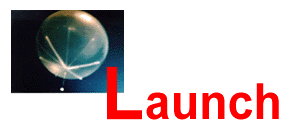
 |
|
Figure 1. High Bay, Palestine, Texas. |
Figure 2. TopHat Payload being assembled. |
A
balloon flight is relatively simple. The balloon is partially filled with helium
and launched with the payload
suspended beneath it. As the balloon rises, the helium expands and fills
out the balloon until it reaches its peak altitude two to three hours after
launch.
A large balloon is almost 500 ft across (about the size of a football field),
when it is fully inflated. When the balloon reflects the light of the sun as
the sun sets, the balloon glows and looks like a huge planet. The balloon base
is prepared for reports of UFO sightings with every balloon launch!
Figure 3.
Aerial View of the Launch Pad
This is an image of a balloon just as it is being launched. The launch pad is designed with "fingers" extending outwards so that the balloon launch team has room to move just in case the winds change. Sometimes balloons are launched from locations where there is no launch pad specifically designed for the purpose. In that case, regular airstrips are used instead.
|
Figure 4. The launch vehicle, Tiny Tim. |
Figure 5. Danny Ball, of the Palestine, Texas balloon base holding the spool. |
The launch vehicle named Tiny Tim (see Figure 4.), weighs 50 tons. While balloons
have been launched using regular construction cranes, this unique machine has
larger wheels, move faster, and can make tighter turns than a standard crane.
They are much less likely to turn over in case they need to move around quickly.
The payload is suspended between the red jaws at the front of the vehicle.
Tiny Tim holds a
pin with cup-like grips. The gondola is attached underneath the pin and the
balloon is attached above the pin. This pin is approximately two feet long and
3 inches in diameter. The balloon is laid out carefully, as the material it
is made from is very delicate. The balloon is pinned down by a spool (see Figure
5 above). The "top" half of the balloon is filled with helium, while the bottom
half is left to rest until release. The balloon is only partially filled to
allow for expansion as the balloon gains altitude. After the balloon is filled
the spool latch is released. This causes the spool to pivot up and release the
uninflated part of the balloon. The blue padded arm seen in Figure 5. is to
ensure that the spool stops when it is upright.
When the balloon is released, it rises in the general direction of the payload (depending on the wind). Tiny Tim is then driven so that the gondola is directly under the balloon. This is necessary to ensure that the gondola does not slam to the ground when the whole package is released. With the gondola under the balloon, Tiny Tim opens its arms and off goes the package, climbing at a steady rate until it reaches its final altitude.
The Launch Team:
There are three
critical members of the launch team:
The Launch Specialist, the Driver and the Electronics
Specialist
The Launch Specialist:
The Launch Specialist is the individual who decides the exact moment when
the launch vehicle releases the package and lets the balloon take off. The Launch
Specialist position demands a lot of experience because there are no second
chances.
The Driver:
The next member of the launch team is the Driver. The driver is in constant
communication with the Launch Specialist through a head set. The Driver needs
plenty of skill to be able to maneuver the launch vehicle at top speeds if necessary
so that the balloon stays directly over the payload and can be released from
the launch vehicle without getting tangled up.
The Electronics Specialist:
The third member of the team is the Electronics Specialist. The Electronics
Specialist controls a special electronics box designed to send a signal to immediately
terminate the flight if a launch gets into trouble. This could happen if the
balloon is defective or there are other difficulties with the launch procedure.
These types of launch terminations have rarely happened.
Equipment:
By launch day not only has the payload been calibrated and assembled, but
the interface package which sends back telemetry
information has been tested and calibrated as well.
Weather:
Weather conditions are extremely important. Balloons can move very quickly.
On launch day the wind must be less than 6 knots (6.9 mph) at the surface, and
less than 12 knots (13.8 mph) going up to 1000 feet. The direction of the wind
needs to be steady so the launch operators can predict which way the balloon
will start to move. As the balloon comes off the ground it will move with the
wind.
Launch,
continued.
SCIENCE | INSIDE BALLOONS | LAUNCH | GET INVOLVED | TOUR A BALLOON BASE | WHY A BALLOON? | GLOSSARY | GUESTBOOK |